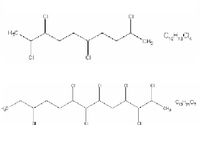C10-13-cloroalkanes
Definition of C10-13-chloroalkanes:
C10-13-chloroalkanes are UVCB substances (Substances of Unknown or Variable Composition) with varying chlorine contents (up to around 70% by weight) and carbon chain lengths (between C10 and C13)[1]. They are yellowish oily liquids, runny or thick, without a distinct melting point, but undergo a process of thickening at temperatures below 35 °C[2].
This is the common definition for C10-13-chloroalkanes, other definitions can be discussed in the article
|
Notes
| C10- and C13-chloroalkane |
|---|

|
| Formula |
| C10H18Cl4 and C13H21Cl7 |
They were mainly used as industrial metal working fluids in processes involving cutting, drilling and stamping metal in engineering and manufacturing. Because of their fire retarding properties, C10-13-chloroalkanes are used as an additive in rubber, especially for conveyor belts. They can also be used in paints and other coatings, leathers, textiles and in sealing compounds. Their use in metal working fluids and for fat liquoring of leather has been prohibited in the EU since January 2004.
C10-13-chloroalkanes were mainly released to water as a result of fugitive emissions during manufacture and use as metal working fluids. Accidental releases during transport and storage also resulted in environmental contamination. They have a low volatility which causes only limited amounts to be evaporated into the atmosphere where they are degraded rather rapidly[2] [1].
C10-13-chloroalkanes have a low water solubility (between 0,15 and 0,47 mg/l) and a strong tendency to adsorb to organic matter and soils. In marine waters they are not considered to be easily degraded, and can be very persistent in the soils with a possible half-life of over 450 days.
The substance has a high bioaccumulation potential. This is confirmed by experiments with fish which could accumulate concentrations up to 8000 times those in the surrounding water. Bioaccumulation has also been confirmed in other species such as molluscs. Therefore C10-13-chloroalkanes are considered likely to biomagnify through food chains[1].
C10-13-chloroalkanes are very toxic for zooplankton. Prolonged exposure to concentrations above 16,3 µg/l have been shown to cause mortalities to a water flea species. Prolonged exposure to concentrations above 300 µg/l is toxic for fishes. Because of their potential to biomagnify C10-13-chloroalkanes could pose threats of secondary poisoning towards fish eating sea birds and marine mammals. Prolonged daily administration of doses of 100 mg of C10-13-chloroalkanes per kilogram of body weight has been shown to damage the livers and kidneys of rats[1] .
Environmental standards and legislation
Included in the water framework list of priority substances
References
Please note that others may also have edited the contents of this article.
|